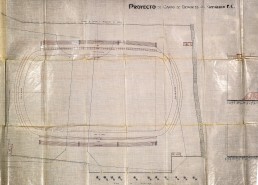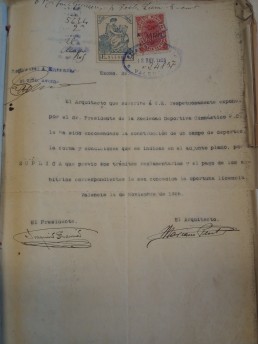It was not just any Sunday. Gimnástico were competing on a cold afternoon on 29 November 1925 in the regional competition. Atletico Saguntino’s team-mates were measuring the reliability and endurance of the dean in an electric duel, but everything was new. Gimnástico, and their social mass, were settling into Vallejo’s home ground.
The distance, in geographical terms, between the Stadium Valenciano, their previous home, and the Vallejo stadium was barely imperceptible. The azulgrana squad left the Turia riverbed to move to Calle de Alboraya. However, the leap undertaken was of colossal dimensions. It was a festive day resolved with a remarkable and enlightening victory (6-0). The Vallejo Stadium held out heroically until the end of the sixties.
The file on the construction of Vallejo stands the test of time as part of the legacy of the city’s Historical Archive. The document, which also includes a beautiful elevation of the sports complex in the form of a plan, offers additional information on its final construction. The architect Mariano Peset was responsible for the work, as the exhumed documentation, presented on 14 November 1925, proves.
Joaquín García, as president of Gimnástico, applies for a licence to build a sports ground in Calle de Alboraya. The builder follows the established steps and demands the corresponding taxes in order to be granted the desired licence. Their respective signatures verify the request. However, the resolution of the file is not immediate.
The Ensanche Commission ruled in a subsequent report. This body determined that the project did not comply with the ordinances, as it encroached on spaces that would in the future become public roads. For this reason, it proposed to the Mayor’s Office that Gimnástico accept the granting of a provisional licence and renounce, in a public deed, the value of the works that do not comply with the Ordinances. The football club would not be authorised to claim compensation in the hypothetical case that the Town Hall decreed an expropriation or demolition by claim of the neighbours.
However, Gimnástico, which agreed to this proposed approach, was not the owner of the acquired land. The company leased a plot of land belonging to the Martínez de Vallejo Morand family. The relinquishment had to be consensual between the parties involved, i.e. owner and lessor. The process was delayed. Manuel Bello succeeded Joaquín García as the representative of Gimnástico, as the file proves.
Furthermore, Juan Martínez de Vallejo Morand’s mother’s serious health problems delayed the signing of the deed due to the impossibility of travelling to the Notary chosen by the Town Hall. On 7 July 1927, Juan Martínez himself proposed the granting of an extension due to his mother’s delicate condition. In fact, María Morand Laborde-Boix died during the course of that year. On 18 December 1927, the siblings Juan and Ana Martínez de Vallejo Morand acknowledged the death of their mother, stating that they were the sole owners of the estate.
However, it was not possible to execute the title deeds until the division of the estate had been completed. It was in 1928 when the City Council granted the provisional licence. The Gimnástico, at that time, had already acclimatised to the facility. Its presence was constant from the end of November 1925. The minute book of the society again gives clues about the construction of the Vallejo Stadium. In the meeting of 1 August 1925, there is a first approximation.
The directors explain the state of the negotiations with the Martínez de Vallejo y Morand family aimed at arranging the lease of an orchard located in Alboraya street. It was a necessity after the termination of the contract that linked them to the Stadium Valenciano S.A. In the following months, the coliseum would gain importance in the imagination of the gymnastic fans. In the Extraordinary General Meeting at the end of August 1925, there was a debate about the formula chosen to raise funds for the raising of the Sports Ground. A commission is appointed to capitalise the work. The sale of Pro-Campo shares is established, to be subscribed by all the members.
The response is remarkable in view of the considerations set out at the General Meeting of 15 September 1925 by the Chairman of the Pro-Campo Committee, although in the following weeks this committee tries to stimulate the sale of bonds among the members. The board of directors is even in favour of granting amnesty to members in arrears in exchange for the subscription of Pro-Campo shares. On this date, the presidency admits that the contract for the construction work in Vallejo amounts to 40,000 pesetas, which the board assumes and takes responsibility for the guarantee of the chosen contractor.



